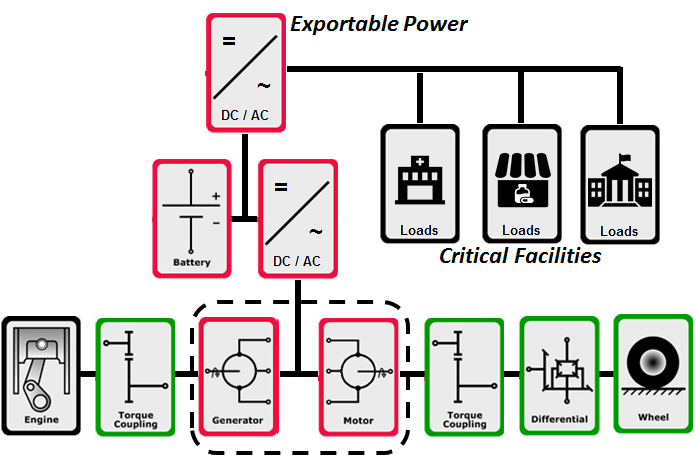Resilience and Pandemics
By Michael Lewis, Robert Hebner
The COVID-19 pandemic highlights another critical link between healthcare and electricity. The preponderance of ventilators is electric, and ventilators are the key tool to reduce the likelihood of death from COVID-19. So, electric power is not just important for the overall functioning of the facility, it is critical for direct patient care.
An important reason this fact is not newsworthy for mass media is that a major electrical outage has not occurred during the current pandemic. The publicly available data indicate that the effect of the pandemic is to reduce total demand and shifting demand to more residential areas. From a grid perspective, this likely reduces the risk of a widespread outage but may enhance the chance of local distribution issues and most importantly, hospitals can be located in largely residential areas.
The success so far is not accidental. Both power companies and hospitals prepare and practice for extreme events. Both are critical industries, so the public expects and pays for, a high level of resiliency in both. For example, hospitals have back-up power in the unlikely event of a power failure.
But to stay cost effective, these organizations prepare for expected problems, not for unlikely combinations, i.e., they prepare for the “or”s but not so much for the “and”s. For example, a utility may be well prepared for a hurricane or a fuel shortage or a pandemic but not so much for a hurricane and a fuel shortage and a pandemic.
The world is now experiencing a pandemic that overloads hospitals for weeks to months around the world. Given sufficient number of stressed hospitals and sufficient time, power interruptions will occur. The back-up generators in some hospitals will inevitably not meet the demand presented by the overloaded hospital or will fail for one reason or another. Back-up generator failure during emergency use is rare, but not impossible. For example, during Hurricane Irma, local governments workers in Southwest Florida had to venture out in the storm to fix a generator that failed at a medical shelter [http://www.govtech.com/em/disaster/After-Hurricane-Irma-Many-Ask-How-Safe-are-Shelters. html] Given the past experience, it would not be surprising if isolated problems occurred between the time this paper is written and published.
After Hurricane Sandy, there was an emphasis on microgrids to enhance the resilience of the power grid. This reflects the fact that while a highly interconnected grid is usually a cost effective and reliable way to distribute electricity, it is also vulnerable to spreading the effects of localized damage to wider areas. At the same time, utilities worked to become better, faster, and smarter at mitigating and recovering from storm damage.
Transportation electrification is beginning to provide another option for resiliency. Electric vehicles are microgrids on wheels. Consequently, there has been research on how to use these vehicles for grid augmentation, routinely or in the case of an emergency. The Pecan Street Project was a Smart Grid demonstration project in Austin, TX. One of the things that it showed is that houses in the study typically drew an average power of about 1 kWh/h. It did not take long to realize that a house with that power requirement could be operated indefinitely in Austin using rooftop solar and a hybrid automobile [D. P. Tuttle, R. L. Fares, R. Baldick and M. E. Webber, "Plug-In Vehicle to Home (V2H) duration and power output capability," 2013 IEEE Transportation Electrification Conference and Expo (ITEC), Detroit, MI, 2013, pp. 1-7.]
It is intuitive, however, that it would be a daunting engineering challenge to use cars to run a hospital. Fortunately, the US Department of Transportation recently released a study that explored a higher power source, transit buses [https://www.transit.dot.gov/research-innovation/bus-exportable-power-supply-beps-system-use-strategy-investigating-use-transit].
The project developed a Bus Exportable Power Supply (BEPS) System to give hybrid buses the capability to act as on-demand, mobile electrical-power generators. This technology was developed to be useful in emergency situations when traditional power supplies are not reliable.
Although there tend to be generators available during emergencies, transit buses are particularly attractive because they can be driven to where they are needed. While there are some types of emergencies, e.g. flooding, in which transit buses may be in high demand for evacuations that has not been the case in this pandemic. Rather, as the pandemic worsens in a city, mass transit tends to be less used.
Modern hybrid electric buses can produce more than 200 kW of power, or the equivalent of the demand of about 200 houses. This is not sufficient to fully power a large urban hospital, paralleling buses combined with demand management approaches could provide good ride through capabilities until a permanent solution is possible. The DOT study predicted that for outages less than a weeklong, the transit bus was less costly than additional back-up power rental or ownership.
Obviously, buses do not automatically plug into buildings. Both the bus and the building have to be modified to make a safe and reliable connection. The DOT study modified one bus and building and demonstrated successful operation.
So far, the pandemic is underscoring the effectiveness of the planning and preparation of the utilities. But as it spreads and lingers on, it is expected to expose isolated examples of lower reliability. Grid and distribution operators will do what they can to strengthen their systems under this stress. Hospital operators will try to assure excellent performance of their back up systems. Emergency backup generators are available. But transportation electrification promises to provide an additional disaster mitigation technology in urban areas- the areas hardest hit by the pandemic.
In the longer term, engineers are developing a smarter grid, smarter backup power, smarter vehicles that can provide power to the grid or, if the grid is down, directly to key loads, and smarter buildings. As these systems begin to better communicate with each other, the world should be even better prepared to provide reliable power in future pandemics than it is today.

Schematic of the modified bus power train for dual use for mobility and a mobile power plant. The change from a hybrid bus is the addition of an output converter.
This article edited by Pardis Khayyer
For a downloadable copy of May 2020 eNewsletter which includes this article, please visit the IEEE Smart Grid Resource Center.


To have the Bulletin delivered monthly to your inbox, join the IEEE Smart Grid Community.
Past Issues
To view archived articles, and issues, which deliver rich insight into the forces shaping the future of the smart grid. Older Bulletins (formerly eNewsletter) can be found here. To download full issues, visit the publications section of the IEEE Smart Grid Resource Center.




